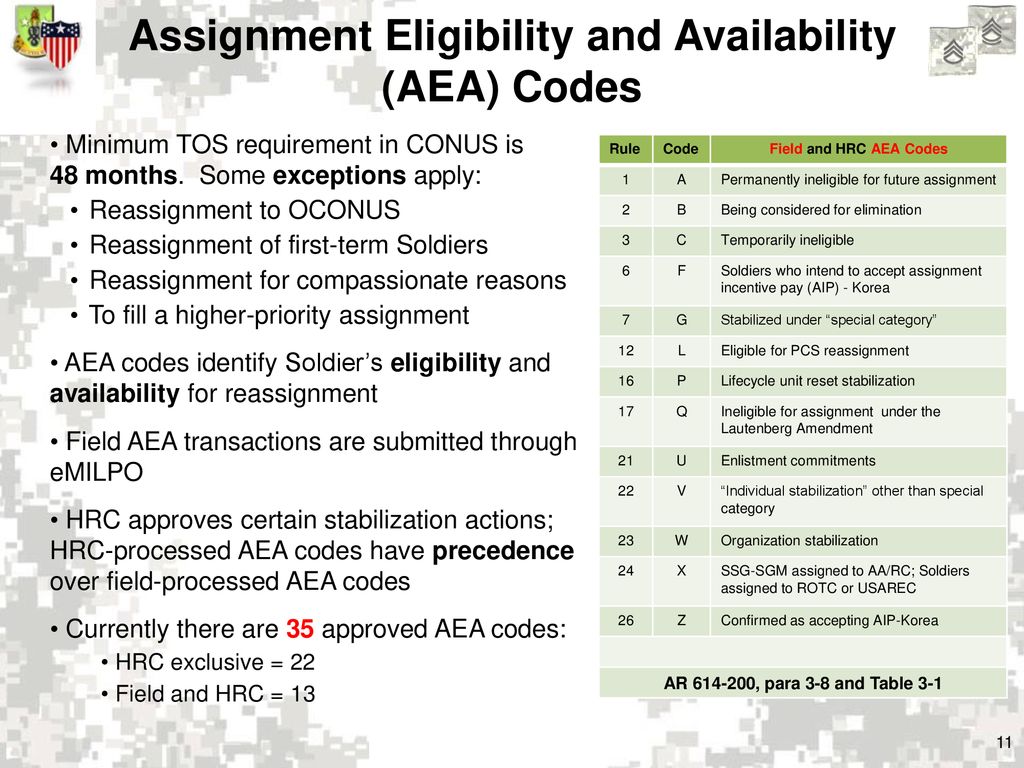The AEA codes are important for determining eligibility for certain programs and assignments. For example, AEA L indicates eligibility for assignment. AEA I indicates selection to an officer producing candidate school (OSC) or to a WOCS. To apply for stabilization, soldiers should complete DA Form 4187, which is due between March and September. Stabilization application windows also apply to year-round schooling programs.
AEA code l
What is AEA code L? It is an acronym for Aircraft Electronics Association. It means that no reassignment restrictions exist. When you get an AEA code L, you can expect to have a lot of flexibility in your career. You can choose to stay in the same field, change your career, or even switch jobs.
The AEA code is a temporary restriction on assignment. During this time, you cannot get a PCS order until the code expires. Soldiers are not eligible for PCS orders when they have an AEA code.
AEA code R
Soldiers who are deployed to OCONUS must meet certain time restrictions before they can be assigned to their new duty station. They should contact their local levy section or installation HRC phone roster to find out how to meet these requirements. Once they have met these time restrictions, they should enter the date of loss in their ERB.
There are different AEA codes for Soldiers based on their grade level. For example, a Soldier stabilized with an AEA D code for a higher grade cannot be assigned to a different grade. However, units can request a stabilization extension through the HRC. If the request is approved, the Soldier’s new assignment will be classified as AEA G.
AEA code S
The revised AEA code S was approved by the AEA Executive Committee on April 20. The AEA thanks all members who provided feedback on the initial draft. The AEA will consider all comments submitted. It will continue to develop and update the Code. This report will be made available to members for review.
AEA code T
The AEA code T is no longer used for soldiers who are currently deployed or returning from an OCONUS deployment. However, when soldiers are deployed, their time on station requirements must be met. If you find yourself in such a situation, contact your local or installation Levy Section to learn more about your time on station requirements. You can also contact your branch manager through the HRC phone roster.
The Army Retention Program (ARP) program is a commander-led program, following specific policies, directives, and guidance. It is imperative that commanders understand and implement the “Whole Soldier” concept. This means that the program is not only designed to help you retain your Soldier, but also to teach you how to be a good leader.
AEA code U
An AEA code U is not an automatic demotion. It can be used for a Soldier whose current grade does not meet the eligibility requirements for advancement. It does not prevent a Soldier from attending selection, volunteer for nominative assignments, attend SFAB or Special Duty units, or attend DS/DASR. However, it may prevent a Soldier from advancing to a higher grade.
For a Soldier to be eligible for an AEA code, he must have completed a master gunner course. Upon graduation, he will be stabilized for 18 months. Upon graduation, he will automatically receive the AEA code “G.” This code is associated with a Special Category Stabilization, and the HRC will enter this code automatically in his or her personnel file.
